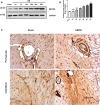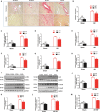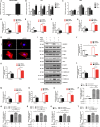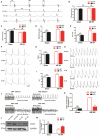Deletion of Microfibrillar-Associated Protein 4 Attenuates Left Ventricular Remodeling and Dysfunction in Heart Failure
- PMID: 32856514
- PMCID: PMC7660778
- DOI: 10.1161/JAHA.119.015307
Deletion of Microfibrillar-Associated Protein 4 Attenuates Left Ventricular Remodeling and Dysfunction in Heart Failure
Abstract
Background Cardiac remodeling predisposes individuals to heart failure if the burden is not solved, and heart failure is a growing cause of morbidity and mortality worldwide. The cardiac extracellular matrix not only provides structural support, but also is a core aspect of the myocardial response to various biomechanical stresses and heart failure. MFAP4 (microfibrillar-associated protein 4) is an integrin ligand located in the extracellular matrix, whose biological functions in the heart remain poorly understood. In the current study we aimed to test the role of MFAP4 in cardiac remodeling. Methods and Results MFAP4-deficient (MFAP4-/-) and wild-type mice were subjected to aortic banding surgery and isoproterenol to establish models of cardiac remodeling. We also evaluated the functional effects of MFAP4 on cardiac hypertrophy, fibrosis, and cardiac electrical remodeling. The expression of MFAP4 was increased in the animal cardiac remodeling models induced by pressure overload and isoproterenol. After challenge of 8 weeks of aortic banding or 2 weeks of intraperitoneal isoproterenol, MFAP4-/- mice exhibited lower levels of cardiac fibrosis and fewer ventricular arrhythmias than wild-type mice. However, there was no significant effect on cardiomyocyte hypertrophy. In addition, there was no significant difference in cardiac fibrosis severity, hypertrophy, or ventricular arrhythmia incidence between wild-type-sham and knockout-sham mice. Conclusions These findings are the first to demonstrate that MFAP4 deficiency inhibits cardiac fibrosis and ventricular arrhythmias after challenge with 8 weeks of aortic banding or 2 weeks of intraperitoneal isoproterenol but does not significantly affect the hypertrophy response. In addition, MFAP4 deficiency had no significant effect on cardiac fibrosis, hypertrophy, or ventricular arrhythmia in the sham group in this study.
Keywords: cardiac remodeling; extracellular matrix proteins; heart failure; microfibrillar-associated protein 4; pressure overload.
Conflict of interest statement
None.
Figures









Similar articles
-
Tumor necrosis factor-alpha mediates cardiac remodeling and ventricular dysfunction after pressure overload state.Circulation. 2007 Mar 20;115(11):1398-407. doi: 10.1161/CIRCULATIONAHA.106.643585. Epub 2007 Mar 12. Circulation. 2007. PMID: 17353445
-
Lack of tissue inhibitor of metalloproteinases 2 leads to exacerbated left ventricular dysfunction and adverse extracellular matrix remodeling in response to biomechanical stress.Circulation. 2011 Nov 8;124(19):2094-105. doi: 10.1161/CIRCULATIONAHA.111.030338. Epub 2011 Oct 10. Circulation. 2011. PMID: 21986284
-
Osteopontin RNA aptamer can prevent and reverse pressure overload-induced heart failure.Cardiovasc Res. 2017 May 1;113(6):633-643. doi: 10.1093/cvr/cvx016. Cardiovasc Res. 2017. PMID: 28453726 Free PMC article.
-
Microfibrillar-associated protein 4 in health and disease.Matrix Biol. 2022 Aug;111:1-25. doi: 10.1016/j.matbio.2022.05.008. Epub 2022 May 26. Matrix Biol. 2022. PMID: 35644509 Review.
-
Gene expression in fibroblasts and fibrosis: involvement in cardiac hypertrophy.Circ Res. 2002 Dec 13;91(12):1103-13. doi: 10.1161/01.res.0000046452.67724.b8. Circ Res. 2002. PMID: 12480810 Review.
Cited by
-
Srxn1 Overexpression Protect Against Cardiac Remodelling by Inhibiting Oxidative Stress and Inflammation.J Cell Mol Med. 2025 Mar;29(6):e70432. doi: 10.1111/jcmm.70432. J Cell Mol Med. 2025. PMID: 40111164 Free PMC article.
-
Reliability and feasibility of automated function imaging for quantification in patients with left ventricular dilation: comparison with cardiac magnetic resonance.Int J Cardiovasc Imaging. 2022 Jun;38(6):1267-1276. doi: 10.1007/s10554-021-02510-x. Epub 2022 Jan 3. Int J Cardiovasc Imaging. 2022. PMID: 34981208
-
Follistatin-Like-1 (FSTL1) Is a Fibroblast-Derived Growth Factor That Contributes to Progression of Chronic Kidney Disease.Int J Mol Sci. 2021 Sep 1;22(17):9513. doi: 10.3390/ijms22179513. Int J Mol Sci. 2021. PMID: 34502419 Free PMC article.
-
Declined plasma microfibrillar-associated protein 4 levels in acute coronary syndrome.Eur J Med Res. 2023 Jan 18;28(1):32. doi: 10.1186/s40001-023-01002-z. Eur J Med Res. 2023. PMID: 36650606 Free PMC article.
-
Identification of candidate biomarkers and therapeutic agents for heart failure by bioinformatics analysis.BMC Cardiovasc Disord. 2021 Jul 4;21(1):329. doi: 10.1186/s12872-021-02146-8. BMC Cardiovasc Disord. 2021. PMID: 34218797 Free PMC article.
References
-
- Cohn JN, Ferrari R, Sharpe N. Cardiac remodeling–concepts and clinical implications: a consensus paper from an international forum on cardiac remodeling. Behalf of an international forum on cardiac remodeling. J Am Coll Cardiol. 2000;35:569–582. - PubMed
-
- Misra A, Mann DL. Treatment of heart failure beyond practice guidelines. Role of cardiac remodeling. Circ J. 2008;72(suppl A):A1–A7. - PubMed
-
- Aimo A, Gaggin HK, Barison A, Emdin M, Januzzi JL Jr. Imaging, biomarker, and clinical predictors of cardiac remodeling in heart failure with reduced ejection fraction. JACC Heart Fail. 2019;7:782–794. - PubMed
Publication types
MeSH terms
Substances
LinkOut - more resources
Full Text Sources
Molecular Biology Databases
Miscellaneous

